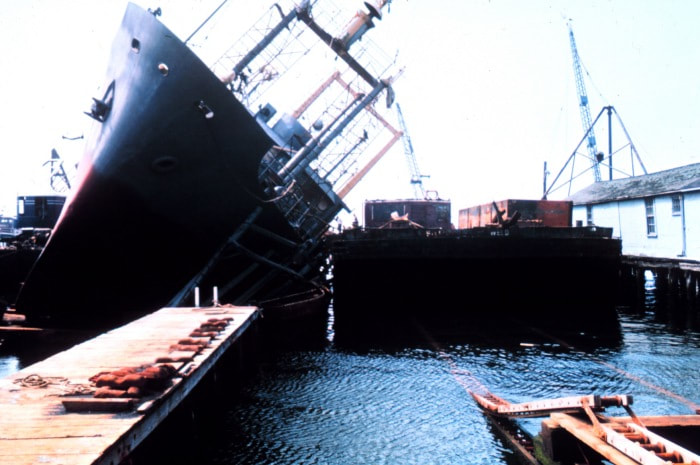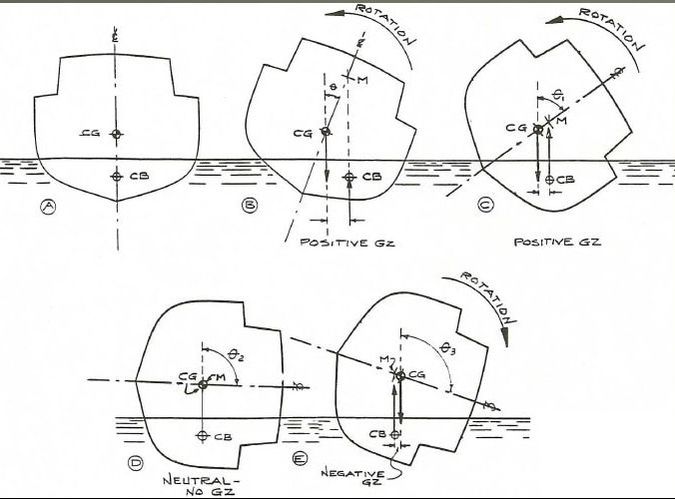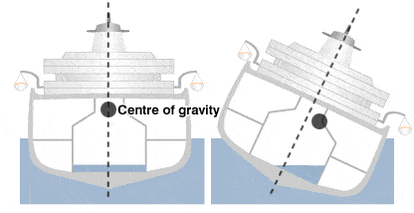|
Recently, one of the owners on the Serenity suggested adding a hot-tub on the upper deck; I was glad when the rest of the membership voted it down for a variety of reasons (maintenance, upkeep, structural concerns, etc.), but one of the primary reasons for my opposing this proposal was that of stability. The stability of your vessel is something that recreational boaters very rarely take into consideration, but when you’re dealing with a larger vessel like our houseboat and a modification that will place thousands of pounds of water high up on that vessel, it’s something that must be factored in. In the commercial or government world any modifications to a vessel (even small vessels) would go through extensive engineering review and, if they were major enough to result in changes to the stability characteristics of the vessel, would require inclining the ship to determine the new stability values. Every ship is inclined when built to determine its stability characteristics, which essentially requires shifting large weights from one side of the ship to the other and measuring how far the ship heels over, which allows the determination of the metacentric height. The photo below of the NOAA Ship Delaware II is not exactly how an inclining experiment should go. The metacentric height (GM) is defined as the distance between the center of gravity (G) and the metacenter (M). The greater metacentric height, the greater the stability of the vessel. While you might think that just maximizing the metacentric height would be the best option, that results in what is referred to as a stiff ship and should be avoided. The term stiff ship refers to a ship that has excessive stability. The characteristics of a stiff ship would be a very short rolling period, which means the ship would return to upright after being heeled over very quickly and result in a very snappy and uncomfortable ride. The center of gravity is essentially the center of mass, and can be shifted by moving loads to different locations on the vessel (e.g. placing more weight lower in the hull will lower the center of gravity, and placing more weight up high will raise the center of gravity). The metacenter is a fixed point through which the buoyant force acts. Put another way, as the vessel heels over, the center of buoyancy shifts; if you drew a vertical line through the center of buoyancy at various states of heel, they would all intersect at the metacenter. The distance between the vertical line and the center of gravity is referred to as the righting arm (GZ) and results in a righting moment that pushes the vessel back to upright. As I stated above, having too much stability results in a very large righting moment and a “stiff ship.” Not only will this vessel be uncomfortable, but the quick, snappy righting can cause cargo to shift, throw loose gear/people about, and can cause structural damage. The opposite of a stiff ship is called a tender ship, which has a very small metacentric height and, as a result, a very small righting moment. A tender ship has a very long roll period, which means that the vessel will return to upright very slowly and has insufficient stability. A “tender ship” will resist rolling less, will roll more steeply, and will tend to remain heeled over for a longer period with a higher likelihood of capsizing. Neither a stiff nor a tender ship is desirable, but you want to be in a happy middle ground. Calculating the stability is not a trivial matter. Marine architects and engineers will have calculated values for the construction of any vessel, but these must be verified to complete the final modeling of the stability of the vessel and that is where the inclining experiment comes in. Once that test is done, the values are verified and placed in the ship’s stability book (now probably a computer program), which the master and chief engineer will consult every time they load the ship to determine the vessel’s stability prior to leaving port. Any major modifications, like adding a large mass up high, would have to be factored in and, if a permanent modification, would require a new inclining experiment to update the stability book. Recreational vessels generally won’t come with a stability book, but should be safe for all normal loading conditions within the limitations of their USCG capacity certification. However, if you start doing things well outside what might be considered normal loading, like adding a hot-tub, you better start thinking about stability. I doubt I could have tracked down any stability information for Serenity and, even if I could, I’d still want to do an inclining experiment. And this doesn’t even start to take into account the free surface effect of the water, which would further reduce the vessel’s stability. The free surface effect essentially refers to the tendency of a liquid in a partially filled tank to slosh to one side when the vessel rolls; that moving mass will increase the roll, which then increases the sloshing, which increases the roll in a positive feedback loop that can result in the loss of stability and capsizing of a vessel. As a result, most tanks on vessels have baffles that prevent fluids from freely communicating from one side of a large tank to the other and mitigate the free surface effect. This phenomenon has been the culprit for many vessel sinkings; particularly on ROROs (Roll-on/Roll-off cargo vessels), which have large open decks that allows water, once on board, to flow freely from one side to the other. The USCG investigation into the recent sinking of the El Faro, a RORO, determined that the free surface effect was the mechanism that ultimately sank the ship.
Needless to say, I was very pleased when our owners decided not to pursue putting a hot-tub on Serenity…besides, who would clean it? Until next time, here’s wishing you fair winds and following seas.
2 Comments
Your blog have been very informative. I am currently working on A 1958 lonestar malibu I rescued from becoming aluminum scrap. I loved the boat the minute I laid eyes on it. I am at an impasse try to remove the streering wheel. Any advice would be grately appreciated
Reply
Brent Pounds
6/30/2018 10:29:50
I'm glad you've found this blog useful. What issue are you having with removing the steering wheel? I ended up breaking the actual steering wheel on mine trying to remove it and replacing the wheel portion with an aftermarket wheel. The shaft, cable spool, and remainder are original though. To get mine off, you needed to remove the center cap of the wheel, remove a retaining nut on the wheel, and then pull the wheel off the steering shaft, which is slightly tapered and has a key for a keyway on the wheel hub. That's where I ran into trouble since the wheel had pretty well fused with the shaft; I applied copious amounts of penetrating oil, but still broke the plastic our around the hub when pulling the steering wheel. Once the wheel is pulled off, the shaft and spool will drop through and come off the back, then you can remove the retaining nut on the housing to remove the remainder of the assembly from the front.
Reply
Leave a Reply. |
AuthorBrent Pounds has over a decade of experience in the maritime industry and has been involved in recreations boating since he was a child. See the About section for more detailed information. Archives
October 2016
Categories
All
|



 RSS Feed
RSS Feed